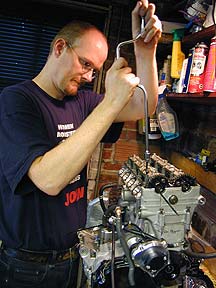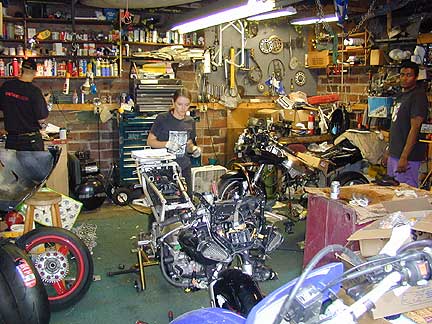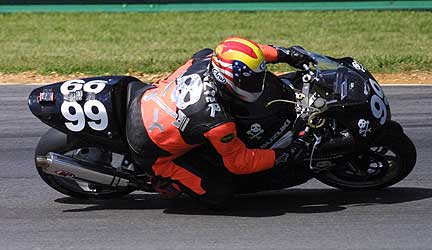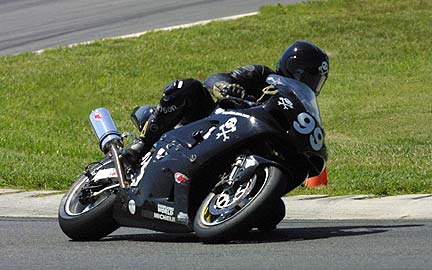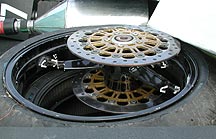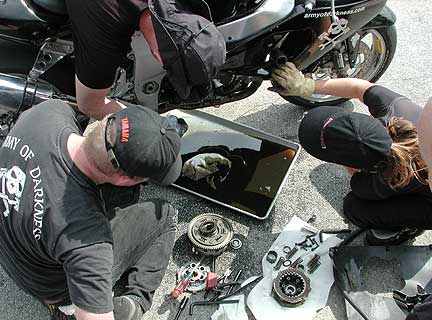2002 – Part Three
AOD Crew Chief Tim Gooding cringes when I say things like "nothing can go wrong now" or "we’ve won our fourth Championship" after only three rounds of racing. Tim works for the Smithsonian Institute in the natural science department. He gets to work with fragments of Mars and the Dead Sea Scrolls, has dredged meteors off the bottom of the Atlantic ocean (that’s a long cable, by the way) and built his own plasma oven for boiling chlorine out of iron meteors. He is a science guy through and through so I am always a little surprised by his superstitious side. It turns out that his stunning ability to make logical connections also explains his raw knuckles from knocking on wood.
Where the magic happens. Tim is
prophylactically replacing the valves
on our engine (affectionately nicknamed
"Dr. Pepper") between races. In hind
sight it is a shame he is not replacing
the transmission. Photo AOD/MOI
The human brain is a wondrous thing but, since we are only about 25,000 years past the last Ice Age, it is still a brain better suited to a hunter-gatherer than for modern post-industrial society.
One of the human brain adaptations which is particularly handy is the ability of humans to recognize patterns. For instance, if I showed you little dots in the pattern of a house or car and asked you what you saw, few would say "lots of little dots," you would close the pattern and say "house" or "car."
The pattern recognition goes beyond visual organization, though, it goes to recognizing patterns such as planting corn in the spring works better than planting corn in the fall or recognizing a tendency for all the buffalo to disappear in the winter so if there is going to be food around it would be a good idea to smoke some meat now. Or, for that matter, recognizing that smoked meat doesn’t rot as fast as raw meat.
The downside to this whole pattern recognition thing is that our brains are always looking for patterns and, hence, we will make connections between unrelated events. For instance, we now know through sophisticated statistics that throwing a virgin in a volcano doesn’t help crops as much as fertilizer and water do.
We also know that superstitions are much more common when or where life is or was a more precarious endeavor. Painting pictures of buffalo on the cave wall might not help with the hunt but who wants to take chance with dinner?
For most of us living large in the USA, securing food is not much of a struggle on a day-to-day basis. Therefore, we don’t worry about wearing lucky underwear to go to the grocery store because we know that we have a pretty good chance of successfully bringing home whatever we want regardless of incantations, bargaining with the ephemeral or attire.
Tim replaces valves, Melissa replaces engines, Nolan assists. Photo AOD/MOI
Winning motorcycle races, however, is very difficult. It is so difficult that even the best riders in the world can’t do it consistently for very long. The same rider who has no superstitious habits when they ride a street or dirt bike will desperately search for that magic pattern which connects preparation to winning the race when they are competing. This could take the form of "this is the shirt I wore the first time I won so I will wear it each race" to requesting divine intervention on the racetrack.
I could prove to Tim using statistics that there is no correlation between what pronouncements we make in the garage and our results at the track, but who wants to take a chance with a race win?
Virginia International Raceway
Danville, Virginia
May 25, 2002
••••••••••••••••••••••••••••••••••••
The fourth race of the season was part of the annual WERA Cycle Jam festivities.
After beating Vesrah II in the last three races, even I started to get quietly optimistic that we might be able to beat them on any given day, and not just when we were lucky.
We had performed our usual race prep (oil change, clean the windshield, guess at the gearing) and the bike felt very strong from the moment we unloaded it from the trailer. VIR’s "straight" does not look particularly fast but we find we usually end up running Road Atlanta gearing to prevent over-revving the engine while leaning right at the finish-line kink.
As it was, even the tall gearing was insufficient for the power Tim’s engine was producing, and the drive Mark Crozier was carrying onto the front straight. We had to drop another tooth on the rear.
The lap times Crozier was turning in practice did not pass un-noticed. In an ironic reversal of the first race of the year, several of the Pirelli-shod riders came over to gripe about the durability of the front tires they had for their endurance bike.
Wearing out the valves. Photo by Vicki Sulpy
On race day Mark Junge announced he would not be riding the 600 and surprised us all by actually not riding the 600. David Yaakov took the start for Vesrah II while Mark Crozier took the start for AOD.
It was the race to watch.
For the first 15 laps they were nose-to-tail. It even looked like the Vesrah bike had a little top-end power advantage on us down the long front straight. We had timed our ca ms and performed assorted other engine modifications on the bike to have more mid-range power for passing in traffic at the expense of top-end power. This decision paid off when Mark and David began to lap traffic. Mark was able to slip by lappers in a few more places on the track and was able to slowly edge away from David. Crozier eventually pulled a small gap but it was all for naught when the first red flag erased all gaps and restarted the race.
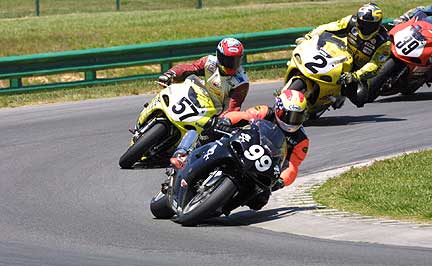
Middleweight riders Mark Crozier (99) and David Yakov (57) lead Heavyweight
Team Extreme (2) and Northern Getaway (39). Photo by Vicki Sulpy.
I did some quick math in my head comparing the time left in the race, the fuel in the tank, probable mileage, the probability of more red flags and the current pace of the race and made the decision to switch riders mid-tank. Denied his usual pre-ride routine, Jim struggled into his leathers while glaring at me for the unexpected change in the riding order.
Yaakov took the restart for Vesrah. Jim and David wore out the tires some more until a red flag reset the grid. They both took the restart again and ran together until Yaakov pulled in for two new tires and load of fuel. Brian Stokes took the bike for what would be Vesrah’s last stint in the red-flag-shortened race.
Jim running alone. Photo by Vicki Sulpy
In the olden days of WERA endurance racing few teams took the time to really shorten their pit stops. Most teams ran little quick-change gear although one or two of the top teams would use the aircraft safety pins on the front calipers. Tim took a good look at a few races and determined that we could gain a few laps just by tightening up our pit stops. So, in 1997, we started taking pit stops seriously. We developed a tank for seven-second fueling and Tim designed and built quick-change gear for 24-second wheel changes front and rear. After witnessing a number of times when bikes returned to the pits, ridden or on crash trucks, with the quick-release calipers hanging from their brake lines, we went with a fixed-caliper swingout-style quick change. The calipers stay on the fork legs and we just swing them out of the way to change the tire. We enjoyed a big advantage with this technique for a number of years but now it has been widely duplicated through the pits. As other teams duplicated our technology, our "win it in the pits" strategy became obsolete.
All of that said, when we refueled and switched rear tires at our only pit stops we actually lost a couple of seconds on Vesrah. When Mark Crozier pulled out of the pits on our bike he was five seconds behind Vesrah’s Stokes. However, Mark was able to pull out about a second a lap and caught up quickly and then steadily pulled away to a reasonably-comfortable 45-second gap. Superstitions or no superstitions, you can never really get comfortable in endurance racing. An object lesson we were to relearn over the next two events.
There are very few fast motorcycle racers in the absolute sense. Most guys who are considered quick only appear so by the level at which they are competing. This phenomenon is often described in hydro-biological terms as "a big fish in a small pond." AOD was a big fish in regional racing in the early-to-mid 1990s, became a small fish in the WERA Nationals, and continued to grow at a pace which would rival an Artic Char (about 0.35-inch per year, making a 30-inch fish about 85 years old). After six years we are now a medium-size fish in a medium-size pond. A couple of victories and setting the pace for 600s in the past few races can give an inflated impression of ability. At VIR veteran endurance and sprint racer Scott Harwell entered the endurance race on a Novice friend’s 600. Due to red flags he rode the race entirely by himself. He would have beaten us save for a late-race fuel stop required by his stock gas tank. He took third overall and bumped Vesrah II off the overall podium.
We finished the race first in the Middleweight Superbike class, second Overall. Vesrah II finished one lap down. 14k, the other official Suzuki team, ran into some problem and finished 31 laps down.
Roebling Road Raceway
Pooler, Georgia
June 8, 2002
••••••••••••••••••••••••••••••••••••
Roebling Road used to be one of the best tracks on the East Coast. That was a long time ago. Roebling doesn’t have pavement; it has an Amish quilt of patches and sealant in the rough shape of a track. This conglomeration of surfaces surpasses expectation in the dry, but is pretty treacherous in the rain.
We were 99 percent sure that the race was going to be dry and were not concerned with getting a good rain set-up and worked in fits and starts to try to get a dry set-up in the brief moments we had on a dry track. Mostly we spent the day waiting for the pavement to dry only to have another little drizzle soak it down again.
Roebling has a couple of long right-handers which are hard on tires. We brought some triple-compound Daytona tires just for this purpose. The triple compounds have a medium side and center, a band of stouter rubber and then a soft edge. We ran them with the hard rubber on the right.
Finally a very large storm blew in, which dampened enthusiasm for riding and all our gear, and I managed to get myself struck by lightning which, after years of symptoms, finally cured my depression.
We took the opportunity of the downtime to have Mike Fitzgerald from Traxxion rebuild our shock and demonstrate the new "Axxion Arm" chassis measuring device. The Traxxion crew determined that my leaking-Buell-induced crash at Portland in the previous season had bent the frame a little bit. There was an uncomfortable pause in the tent after they told us our frame was tweaked. We all looked at each other and sighed a collective "oh, well" and installed the newly-rebuilt shock.
Although we kept rains mounted on rims in the pits, race day was dry and hot.
Despite the lack of adequate set-up work on Friday, our practice times were all good. Mark Crozier was his usual blindingly fast and Jim and I were not far behind.
Mark started against Vesrah’s Brian Stokes and pulled about a 35-second lead in the first stint. The bad news was that our super-trick triple-compound Michelins were only really working for about 40 minutes of a 90-minute stint. The good news was that the Pirellis were only lasting about 30.
We pulled into the pits first. I knelt down with the air wrench to remove the axle only to find that it had loosened on the track and was only being held in by the clip and safety wire. I removed the axle the rest of the way, Tim swapped the wheel and I put the axle back in. However, instead of the reassuring sound of the air wrench losing rpm as the threads stretched in the captive axle nut, the air wrench spun sickeningly freely.
Don’t you hate when this happens?
Photo by Flipper.
We had pushed our home-built captive axle nut too long and it had stripped. This was a stupid error usually only committed by the now-defunct Harley-Davidson road-racing team.
It not being the time for woulda, coulda, shoulda, we scrambled for the spare, made the repair and put Jim out on the bike one lap down on Vesrah II.
At this particular event we were actually pitted in the adjoining pit to Vesrah. Being friends they shared some amount of our grief at the turn of misfortune, but, as competitors, such a mistake is a Godsend. Their loss at Putnam was caused by a smaller error than we had just committed. "There goes the race," I thought.
Moments after our bike left the pits, the Vesrah II bike pitted. Perhaps just slightly distracted by our mistake and eager to capitalize on the windfall lead, one of their crew members didn’t get the chain onto the rear sprocket just right during the wheel change. David Yaakov pulled out of the pit but only made it 10 feet as the chain hopped off the rear sprocket and balled up under the clutch cover, wiping out the clutch pushrod.
They lost eight laps fixing it.
"We just won the race," I thought while trying to determine if the dueling mistakes had a coincidental or a causal relationship.
We showed Jim a "+7L" board to ease his "I’m one lap down" mind. We were running in fourth overall, first in class with a big gap back to everyone else.
At the next pit stop I got on the bike and tried, after not riding in the last few races, to reacclimatize myself to the tasks at hand. I rode quickly but carefully since we had everything to loose at this point.
The stint wore on, the air was hot and riders were beginning to fade in the conditions and crash. I started to miss shifts into turn one. At first I thought I had just failed to take my boot off the shift lever completely between gear changes. For the next few laps I concentrated on being very deliberate in my shifts but the problem reoccurred. It would hang between sixth and fifth or fifth and fourth. With a sinking heart I started to ride even more carefully and deliberately.
Eventually Mark Junge came by on the Vesrah II machine closing our lead to only six laps. A few minutes later his front wheel (a stock Suzuki rim) collapsed, sending Mark tumbling into the tire wall on the farthest, least accessible part of the track from the pits. I had a very good view of the action every 78 seconds or so and watched as Mark initially determined the damage was too extensive to warrant repair, then reconsidered and returned with a rescue crew equipped with an ATV and cart.
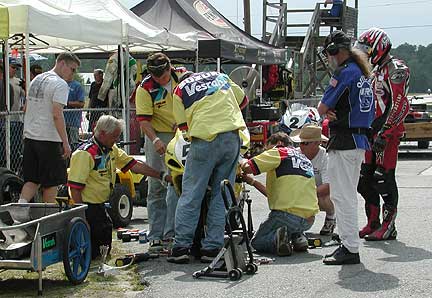
Vesrah II riders Mark Junge (left) and Brian Stokes (right, in leathers) and
miscellaneous Vesrah Crew scramble to recover from "crumpled wheel syndrome."
Photo by Flipper.
My cautious riding had netted us extra fuel mileage and my stint lasted 95 minutes before the orange light began to flash.
While the crew changed the rear tire I told Mark Crozier, suited up for our last stint of the race, that the transmission was tying up and to be very deliberate with the shifting. He returned to the fray but the transmission failed completely shortly thereafter and he returned to the pits.
It became a race of wrenches. Vesrah II was quickly repairing the extensive crash damage from the collapsed wheel. Tim, Melissa and I stripped the clutch out of our bike expecting to see the star gear bolt backed out. It was not. It all looked okay. I stuck it in fourth gear manually, we bolted the bike together and sent Mark out to finish the race with one gear.
"None of the usual stuff is broken. What do we do now?" Photo by Flipper.
Apparently the transmission had been shedding metal into the oil. Four laps later we were out of the race with a spun connecting rod bearing.
Vesrah completed the repairs on its bike and headed back onto the track. I figured out the lead we had on them, the remaining time in the race and walked over to congratulate Mark Junge and the rest of the team on their first victory over us. Superstitious causality or no, five minutes later a crash brought out a red flag, which ended the race with 30 minutes left on the clock. Although finishing in the last few bikes in the field, we still beat our title rivals by 17 laps and increased our point lead significantly.
Both teams were impressed by two aspects of the race: The unexpected reversal in fortunes and the frailty of the Suzukis we were each campaigning.

